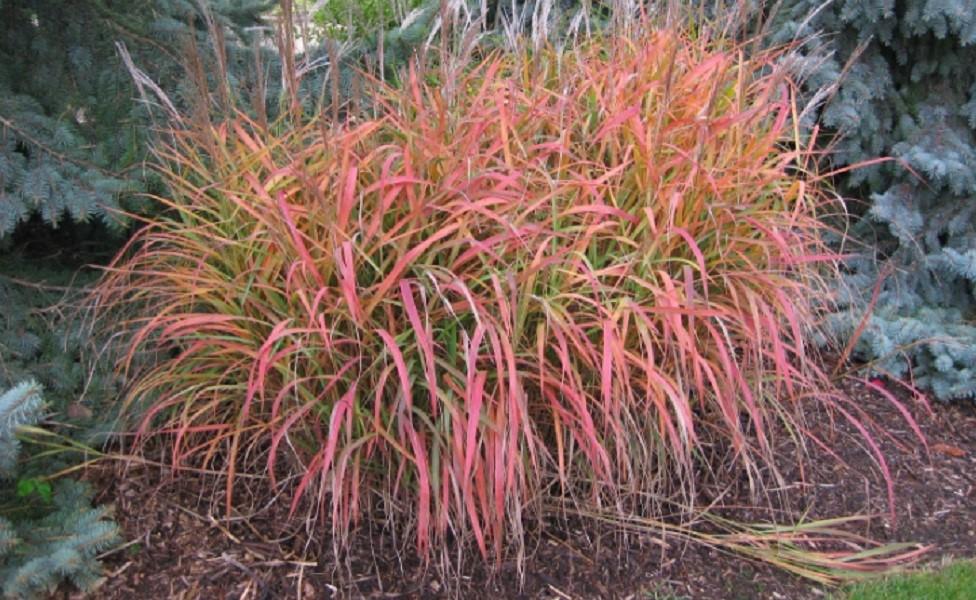Content
Miscanthus chinensis is a herbaceous perennial with a creeping rhizome, hard leathery leaves and an erect stem. It looks impressive when cut and, due to its variety of shapes and colors, is widely used for background plantings and ceremonial compositions.
Description of Chinese miscanthus with photo
Miscanthus or Chinese fan is a spectacular perennial from the Poaceae family, whose natural habitat is Southeast Asia, Africa and the Far East. The plant is a herbaceous bush with creeping rhizomes extending to a depth of 6 m, erect stems crowned with fluffy vera-like panicles, and long, linear, rough-to-the-touch leaves 10-15 mm wide.
With the beginning of the growing season, the shoots and leaves of Chinese Miscanthus quickly gain growth and by summer the perennial turns into a bright green overgrown bush. In autumn, the foliage of the plant changes color.In some varieties it becomes yellow-pink, in others it becomes deep orange, in others it becomes brownish-burgundy.
Miscanthus chinensis usually blooms in July or August and lasts until mid-October. During this period, paniculate inflorescences 10-30 cm long appear on the bush.

The color of the spikelets depends on the variety and varies from white to bright red
The Latin name of the genus Miscanthus chinensis, Miscanthus, comes from two ancient Greek words translated as “petiole” and “flower.” The specific epithet sinensis is an adjective derived from the Latin. sinensi meaning "China".
Winter hardiness of Chinese miscanthus
The plant belongs to frost resistance zone 4-5 (USDA), but specific indicators depend on the variety. Most types of Chinese miscanthus tolerate temperatures down to -34 0C, but it is better to insulate their roots for the winter.

In the cold season, the panicle inflorescences of the plants become silvery, but do not lose their decorative effect
Height and diameter of Chinese miscanthus
The perennial belongs to the category of medium or tall plants. Depending on the variety, Chinese miscanthus grows up to 70-300 cm in height with a diameter of 1 m.
Varieties of Chinese Miscanthus
There are over 100 varieties of Chinese fantail, each of which has its own characteristics:
- Flamingo. The variety is a bush that grows up to 2 m in height. It has solid green leaves and during the flowering period is covered with large inflorescences of a delicate pink-orange hue, reminiscent of the color of the bird of the same name.
- Ferner Osten. The compact, low-growing fanflower grows to 50-70 cm in diameter and blooms at the end of August.The initially bright red panicles turn pink after a month and then turn white, standing out against the orange-red autumn leaves.
- Strictus. Miscanthus is undemanding to soil and watering. With excess moisture, it will grow up to 3 m in height, in dry areas - up to a maximum of 2 m. The green leaves of the plant are decorated with white spots, and the inflorescences that bloom in September are colored in a reddish tint.
- Purpurascens. Miscanthus is an ornamental bush that grows up to 1-1.6 m. With the arrival of autumn, its gray-green leaves acquire a bright red-orange hue, and the initially purple narrow inflorescences gradually turn white.
- Morning Light. The variety is particularly demanding on lighting. It grows up to 2 m and has narrow leaves with characteristic white stripes along the edges.
- Little Zebra. A spreading bush up to 1.2 m high with green leaves strewn with small yellow spots. In September it is covered with soft purple panicles.
- Crater. A compact spherical bush with a maximum height of 1.2 m. It has curved silver-green leaves and during the flowering period is covered with bright red-brown panicles, which gradually turn pale.
- Zebrinus. Light-loving miscanthus with three-meter stems and rich green leaves decorated with golden stripes. During the flowering period, the bush is covered with paniculate silver-lilac inflorescences.
- Gracillimus. The variety is a fast-growing spherical bush with narrow green leaves, decorated with a white stripe in the middle, and paniculate inflorescences formed by small purple-silver spikelets.
- Miscanthus Adagio.Fantail looks like an elegant bush up to 1.2-1.4 m high with thin silver leaves and pink inflorescences, gradually acquiring a creamy white hue.
Landing rules
Miscanthus chinensis is planted in well-warmed soil. In the southern regions this is done at the end of March, in central Russia - a month or a month and a half later. For planting, choose a well-lit, windproof area with any soil other than sandy or clay.
Chinese fantail is characterized by a long growth period, which is why young seedlings often do not have time to acclimatize before the onset of cold weather. Therefore, only adult specimens that are able to quickly adapt to new conditions and calmly endure the winter are purchased for planting in open ground. The place allocated for miscanthus is dug up in advance, cleared of weeds, fed with organic matter and mineral fertilizers, and the planting itself is carried out according to the following scheme:
- In the selected area, holes are dug 20-30 cm deep. When planting several bushes, the distance between adjacent holes should be approximately 1 m.
- A mixture of compost and soil is poured into the bottom of the hole and a mound is formed.
- A Chinese fantail seedling is placed in the center and the voids are filled with the remaining soil.
The soil under the bushes is lightly compacted and watered with non-cold, settled water. To control the growth of miscanthus, fencing is made of slate, iron or boards on the sides of the planting holes. The border is dug into the ground to a depth of 20 cm so that it rises 10 cm above the ground surface.
Caring for Chinese Miscanthus
An unpretentious plant requires minimal care, including:
- Regular watering. The ground under the bushes is moistened with settled warm water as the top layer dries.During periods of heavy rainfall, watering is temporarily stopped.
- Feeding. In the second year after planting, fertilizers are regularly applied to the ground under the Chinese fan. In mid-May, the plant is fed with a urea solution, in June - with liquid humate. At the end of July or August, potassium and phosphorus are added to the soil.
- Trimmings. Miscanthus chinensis is prone to aggressive growth and requires regular pruning. The procedure is carried out twice a year - in spring and late autumn. During the pruning process, dried and rotten stems are removed, as well as shoots that extend beyond the boundaries of the designated area.
Although many varieties of Chinese fantail tolerate frosts down to -34 0C, with the onset of autumn, a frame covered with agrofibre is built over them. If a severe winter is predicted, spruce branches are laid on top of the structure. The tree trunk circle is sprinkled with humus or dry leaves.

With the onset of the first thaw, the shelter is partially removed to prevent the perennial from rotting
Propagation of Miscanthus chinensis
The plant is propagated in several ways. It is usually grown from seeds or obtained by dividing a bush. The vegetative method of propagation is used only as a last resort, since the Chinese type of miscanthus takes a long time to recover from any injury.
Seeds
In autumn, miscanthus seeds are placed in a container filled with nutritious soil mixture and buried no more than 10 mm. The container is covered with film and after the first green shoots appear, it is placed on a lighted windowsill. The cover is completely removed.

Fanflower seedlings are grown at a temperature of +20 0C, periodically watered and, if necessary, illuminated with a phytolamp
Dividing the bush
Although Chinese miscanthus does not like transplanting, every few years it is rejuvenated by dividing along the rhizome. The bush is dug out of the ground, cut into 2-3 parts and planted in individual holes, treating the roots with a growth stimulant and wood ash infusion. Miscanthus propagated in this way retains all varietal characteristics.
Diseases and pests
Chinese fantail is immune to most diseases and is not afraid of pests. Root rot poses a certain danger to the plant, so it cannot be planted where tomatoes and potatoes used to grow.
Of the insects, the fantail occasionally attacks the spider mite.

Having noticed signs of pest damage, the fan is treated with Vartimek or a weak soap solution
Photos in landscape design
The Chinese fan emphasizes the decorative effect of bright flowers and gives the flowerbed lightness and airiness. Therefore, it is often planted in the background to create a background.

The bush looks organic next to many plants
Miscanthus chinensis is most successfully combined with Buenos Aires verbena, spotted sapling, Japanese anemone, purple coneflower, gaura, fescue and lavender.

The plant is successfully used for natural zoning of gardens
Conclusion
Miscanthus chinensis is a spectacular perennial with narrow herbaceous leaves and fan-shaped panicle inflorescences. It is used to design lawns and decorate decorative ponds, as well as to create dry floral compositions.
Reviews of Chinese Miscanthus





















